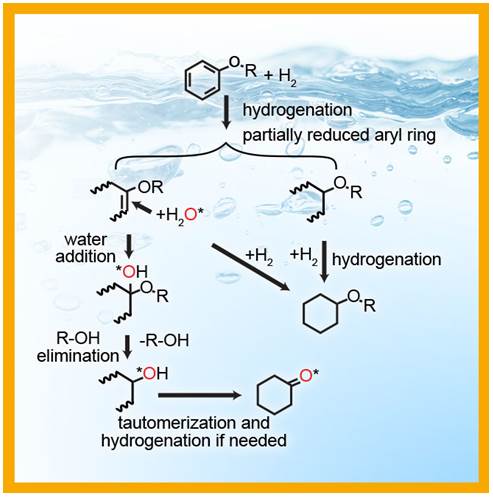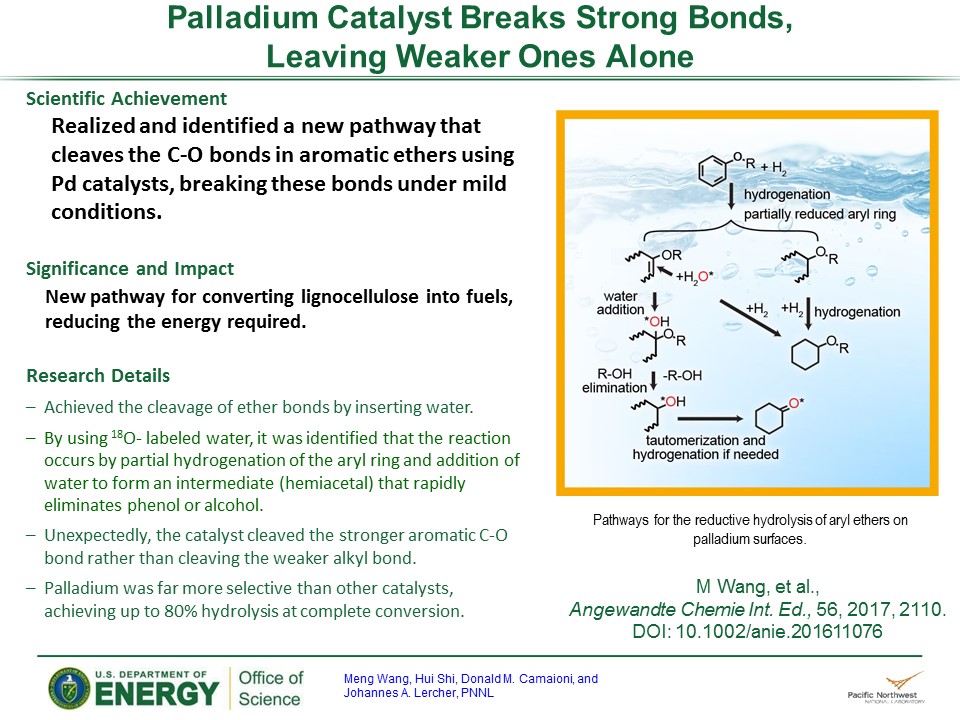Palladium Catalyst Charters A New Path
A new pathway for breaking down biomass feedstocks into fuels emerges
(July 2017)

Cleared slide summarizing research conducted at Pacific Northwest National Laboratory. Download PowerPoint slide
Biomass feedstocks are organic raw plant matter that is used in the production of fuel. The organic units of these complex biopolymers are interlinked by carbon-oxygen bonds, in lignin mostly linking aromatic rings. Industrially, we do not have the knowledge and procedures to economically conduct the deconstruction of the polymers by breaking carbon-oxygen bonds inserting water or H2 in this step. For hydrolytic cleavage, scientists have previously had to use catalysts in hot, supercritical water, while it was possible to cleave the bond at lower temperatures with the insertion of H2. Johannes Lercher, Don Camaioni, Meng Wang, and Hui Shi from Pacific Northwest National Laboratory (PNNL) identified a new pathway that hydrolytically cleaves the carbon-oxygen bonds in aromatic ethers using a palladium catalyst.
Why It Matters: Lignocellulosic biomass is plentiful resource that can be converted into fuel. Biomass consists of interlinked biopolymers, cellulose, hemicellulose, and lignin. Lignin acts as structural material in vascular plants. It is an oxygen cross-linked phenolic polymer that is resistant to facile deconstruction due to the chemical stability of the carbon-oxygen bond in aromatic ethers. Using a palladium catalyst, PNNL scientists found a new pathway to electively cleave aromatic ether bonds, opening a new route to fuels from waste biomass.
Methods: Aryl ethers contain carbon-oxygen bonds that are among the strongest bonds in organic chemistry. The team from PNNL found they could break these bonds via reductive hydrolysis at relatively mild temperatures and pressures of hydrogen using a palladium catalyst in aqueous phase.
"The cleavage of aromatic carbon-oxygen bonds is challenging because of the strength and stability of the linkages, and the process is really an important step for the conversion of oxygen-rich plant biomass to deoxygenated fuels and commercial chemicals," said catalysis scientist Meng Wang.
By analyzing the evolution of products with and without incorporation of 18O- labeled water, the researchers showed that the reaction occurs by a previously unconsidered mechanism.
“At first, the phenyl ring is partially hydrogenated. After adding the equivalent of 1 to 2 molecules of hydrogen to the ring, hydrolytic cleavage of the carbon-oxygen bond is facile,” said Camaioni, a catalysis scientist at PNNL. “The partial hydrogenation of the phenyl ring allowed us to achieve hydrolysis at a much lower temperature.”
A remarkable feature of this "reductive hydrolysis" approach is that the stronger aromatic carbon-oxygen bond, rather than the weaker aliphatic carbon-oxygen bond, is cleaved, highlighting the potential of deploying this mechanism and Pd catalysts for disassembling refractory aryl ether biopolymers.
In addition to the lower temperature required for hydrolysis, the palladium catalyst proved to be far more selective than other catalysts.

Cleared slide summarizing research conducted at Pacific Northwest National Laboratory. Download PowerPoint slide.
"We were surprised by the high selectivity of palladium," said Wang. "Palladium was far more selective than previous catalysts, giving up to 80 percent hydrolysis products at complete conversion."
What's Next? Lercher, Camaioni, and their colleagues at PNNL will continue to investigate the catalysis of reductive hydrolysis and related reactions of biomass feedstocks to improve understanding of ways to control their conversion to fuels.
Acknowledgments
Sponsor: This work was supported by the U.S. Department of Energy, Office of Science, Office of Basic Energy Sciences, Division of Chemical Sciences, Geosciences, and Biosciences.
User Facility: Portions of the work were performed at EMSL, a national scientific user facility sponsored by the DOE's Office of Biological and Environmental Research located at Pacific Northwest National Laboratory
Research Team: Meng Wang, Hui Shi, Donald M. Camaioni, Johannes A. Lercher, Pacific Northwest National Laboratory
Reference: Wang M, H Shi, DM Camaioni, and JA Lercher. 2017. "Palladium-Catalyzed Hydrolytic Cleavage of Aromatic C-O Bonds." Angewandte Chemie International Edition 56:2110. DOI: 10.1002/anie.201611076
